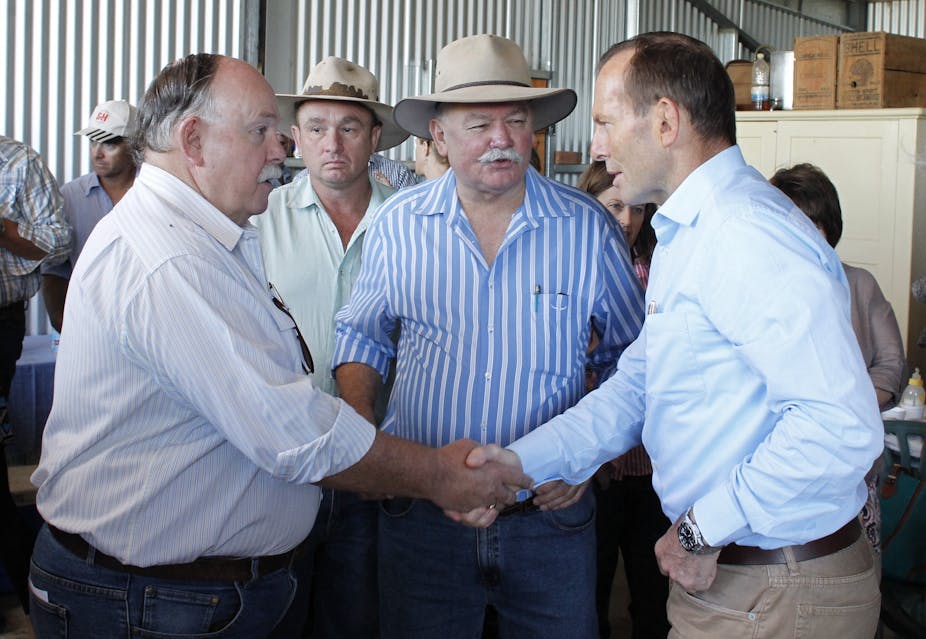Last week’s Commission of Audit advocated a “commonsense approach to handling risks in society,” targeting drought assistance for its role in “discouraging drought preparedness and self-reliance”.
The Commission recommended the Farm Finance Concessional Loans Scheme be abolished. Although earmarked for productivity enhancing investments and debt restructuring, the scheme represents a form of interest rate subsidy, similar to the previously ended ECIRS (Exceptional Circumstances Interest Rate Subsidy).
The Commission’s call mirrors many previous calls from the Productivity Commission, most recently in the 2009 drought review. Yet, Agriculture Minister Barnaby Joyce seems confident the measure will stay. In his view, abolishing the A$700 million concessional loans scheme would be “counterintuitive” to a recently announced and agreed government policy on drought assistance.
Droughts are a feature of the Australian landscape, and farmers have learnt to manage them, but not without significant hardship and financial burden.
As droughts gets more intense and occur more often, as indicated in climate models, farmers are also finding it difficult to cope in an increasingly competitive, globalised economy. Governments around the world are regularly called upon to help farmers.
In the deliberations leading to the next week’s federal budget, it’s worth asking: should farming be considered different to other small businesses seeking government support?
Getting policy right
When looking for policy solutions, it all boils down to the social merits of what governments do, and involves the balancing of opportunity costs. Simply stated, what else could we do with the funds targeted for drought support, and would it make matters worse?
The Commission of Audit argues:
the scheme encourages farms to take on more debt, when there is little evidence to suggest that farm businesses that are viable over the longer term have difficulty accessing commercial finance.
The proposed sale of Victoria’s Rural Finance Corporation (RFC) to Bendigo and Adelaide Bank for A$1.78 billion partly supports the Commission’s view on the commercial viability of rural finance businesses.
When interest rates are at a record low level, businesses that can prove their viability do not find it difficult to access finance.
It is widely believed that at any time of the interest rates cycle, concessional loan schemes carry the risk of distorting incentives for long-term planning such as drought preparedness. It can deter long-term unviable businesses from leaving farming, and thus extend the “agony” that the policy is trying to resolve.
Successive reviews of drought programs since 1997 have found that the ECIRS is ineffective and inequitable. For example, in 2009 the Productivity Commission’s Inquiry into Government Drought Support noted a number of issues. It found the ECIRS may:
- provide incentives to increase debt
- make farm businesses less responsive to drought conditions and
- discourage farm businesses from adopting self reliant strategies.
Misguided incentives such as interest rate subsidies can also drive up property prices and dissuade much-needed new entrants.
Australian farmers are already facing uncertainty relating to changing environmental conditions that affect farming more directly. Farming is becoming increasingly more complex. And better business management, in particular risk management, is becoming the much-needed focus of farming.
While it may be reasonable to assume that the farmers’ risk profile may have changed more than other businesses, it’s important to note that farmers also have access to specific measures to help smooth out income disparities caused by fluctuating market or seasonal conditions.
Farm Management Deposits
Beginning in 1992, the Farm Management Deposits (FMD) Scheme allows eligible farmers to make deposits into a bank account that are tax deductible in the year the deposits are made. The deposits become taxable income in the year they are withdrawn.
FMDs have become popular, particularly over recent years. A review of the scheme found that, although used mainly by mature-aged farmers in the early years of the scheme, with the onset of widespread drought across eastern Australia since 2002–03, the scheme has attracted younger farmers.
By June 2013, the value of FMD’s hit an all-time high of A$3.72 billion. By the end of January 2014, nearly 27% of an estimated 157,000 Australian farmers subscribed to FMDs. The average holding of $76,670, is higher than the highest estimate ($61,600) of the average super savings held by Australians, including farmers.
Distorting signals may be costly
What this suggests is that Australian farmers are taking business risk management seriously and government policies need to encourage such self-protection activities. Addressing mismatches in drought risk management, in particular social concerns that drive governments into quick fix solutions, may be better done through direct social policy.
Distorting the incentives for competitive farms that have invested their savings in preparing for vagaries of weather and other risks in working the land may not be wise.
On the other hand, the government also has a philosophical problem: if debt is bad for good governance, how can a government encourage farmers to take more debt?

